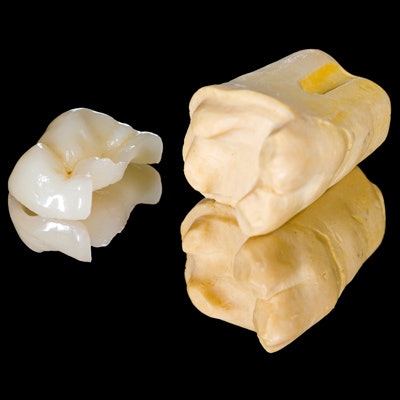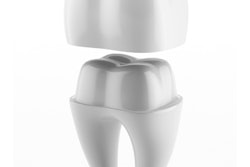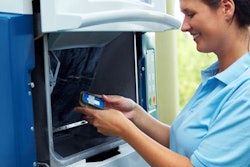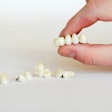
Knowing the translucency levels and masking properties of pressable ceramics can be useful for choosing the right material for an aesthetically pleasing restoration. To learn more, researchers studied the optical properties of one widely used lithium disilicate ceramic system and a newer feldspar ceramic material.
They assessed the translucency and masking properties of IPS e.max Press (Ivoclar Vivadent) lithium disilicate ceramics and the more recently introduced Vita PM9 (Vita Zahnfabrik) feldspar ceramic materials for heat pressing. The Vita materials showed higher translucency values than the IPS ceramics (Journal of Esthetic and Restorative Dentistry, January 25, 2018).
"Highly translucent ceramics must we used with caution when restoring a tooth with discromia, as the color of the stump can be perceived through the restorative material," Cristina Gasparik, DDS, PhD, one of the study's authors, told DrBicuspid.com in an email interview.
Dr. Gaspirik is a lecturer in the Faculty of Dentistry at Iuliu Hatieganu University of Medicine and Pharmacy in Cluj-Napoca, Romania.
Color me translucent
In certain situations, such as the restoration of discolored teeth, opaque restorations are recommended. While zirconium-oxide ceramic is the most opaque ceramic and can mask dark backgrounds, other factors, such as its high surface toughness, frequent chipping of the veneering ceramics, and loss of retention of the restoration, make its use less than ideal, the authors explained.
“Highly translucent ceramics must we used with caution when restoring a tooth with discromia, as the color of the stump can be perceived through the restorative material.”
Heat-pressed ceramics come in a variety of colors and translucency levels and can be a high-performance alternative to opaque restorations. Lithium disilicate ceramic is a commonly used example of a heat-pressed ceramic. However, newer heat-pressed ceramic materials are said to have better aesthetics.
Feldspar ceramics have the highest translucency levels among ceramics because of their high glass content. However, restoring the natural appearance of discolored teeth is more difficult with translucent ceramic materials, according to the authors.
The researchers conducted this study to find out more about the translucency and masking properties of the newer Vita PM9 feldspar ceramic compared with the IPS e.max lithium disilicate ceramic.
They fabricated 15 disks of each material (30 total) in five shades per material (three disks per each color) using the lost wax technique. The disks were each 1-mm thick and 10 mm in diameter. The researchers polished the disks with sandpaper with decreasing grit sizes and then cleaned and removed impurities from the surfaces.
Researchers also fabricated five cylindrical blocks 3 mm in thickness and 10.5 mm in diameter using a universal composite resin Article Body Help (Quadrant Universal LC, Cavex) for simulating tooth-shaded backgrounds (A1, A2, A3, A3.5, A4). A1 was a control background for A1, 1M1, and 1M2 shaded ceramics, and A2 was a control background for A2 and 2M2 shaded ceramics, while the others were test backgrounds.
The investigators then placed the ceramic discs on black, white, and tooth-shaded backgrounds, and used a contact dental spectrophotometer (Vita Easyshade Advance 4.0, Vita Zahnfabrik) to measure CIELAB parameters three times per disk. CIELAB is a three-dimensional color space that includes all colors visible to humans and in which one axis represents lightness. The researchers used these parameters to calculate the translucency parameter for each of the 10 ceramic shades (each with a unique shade code) tested.
| Translucency parameters of tested ceramic materials | |||||
| IPS e.max Press lithium disilicate ceramic | Vita PM9 feldspar ceramic | ||||
| Shade/translucency | Shade code | Translucency parameter | Shade/translucency | Shade code | Translucency parameter |
| A1 low translucency | A1LT | 16.8 | 1M1 translucent | 1M1T | 18.67 |
| A1 high translucency | A1HT | 18.63 | 1M1 high translucent | 1M1HT | 25.18 |
| A2 high translucency | A2HT | 19.7 | 1M2 translucent | 1M2T | 19.57 |
| B1 low translucency | B1LT | 14.96 | 1M2 high translucent | 1M2HT | 24.91 |
| B2 high translucency | B1HT | 18.43 | 2M2 translucent | 2M2T | 19.16 |
They measured the lowest translucency parameters (14.96 and 16.8) for the IPS e.max Press low-translucency shades and the highest (24.91 and 25.18) for the Vita PM9 high translucent options.
The translucent group of the Vita PM9 ceramics demonstrated translucency parameters close to those of the IPS e.max Press high-translucency group. While the translucency parameter was significantly different between the tested ceramics (p < 0.001), it did not vary significantly between groups of ceramics with similar translucency parameters.
The investigators found a significant interaction between the shade of the background and the color of the ceramic materials. The effect of the background on the color of the ceramic disks was different among the groups of materials, with the most translucent shades, the Vita PM9 high translucent shades, showing the greatest color difference on all three of the backgrounds that simulate different dental shades, which implied that they had reduced masking ability.
The researchers found the largest color differences with the A4 background with all tested materials, although the low-translucency IPS e.max Press shade A1LT was close to the acceptability threshold, the smallest color difference noticed by 50% of observers but still considered clinically acceptable. Overall, they found the smallest effect of the background for the Vita PM9 translucent and IPS e.max Press low-translucency shades.
Significant differences existed between the two types of ceramic materials in their translucency and their masking abilities, the researchers reported.
Not glazed over
A limitation of the study was not following a glazing procedure after surface polishing, and this could have influenced the translucency values, according to the authors. Additionally, even though an optical solution was placed between the samples and backgrounds during measurements, the effect of the thickness and color of the cement layer or try-in pastes should be studied further clinically and in vitro, they noted.
"Translucency of the VITA PM9 feldspathic ceramic was higher than that of the IPS e.max press lithium-disilicate, which could be explained by the presence of nanocrystals of lithium phosphate and lithium zinc silicate in the glass matrix of the IPS e.max press, which are responsible for the higher scattering of light in this material and consequently provide a higher opacity," Dr. Gasparik told DrBicuspid.com.



















